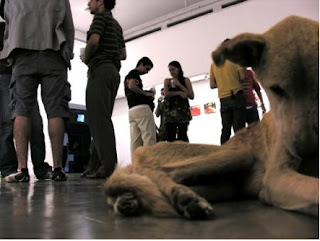
The Costa Rican, conceptual artist Guillermo Vargas has stirred up a lot controversy regarding the death of a street dog during his exposition titled "Eres lo que lees" at the Galeria Codice in Managua, Nicaragua.
He paid two children to capture a dog from a poor neighborhood in Managua to exhibit it in an art gallery. Already in poor condition, the dog (called Nativity) was tied to a wall and refused any care by Vargas' orders. For three days a lot of people observed impassively how the poor dog starved to death. Though there were people in the gallery who wanted Natividad fed and realeased, Habacuc refused to allow it. Does it look like art to you?
This display, Vargas claimed, was a response to the death of Natividad Canda, who was killed in Costa Rica by two rottweilers guarding the place that Canda intended to rob. Vargas meant to show that no concern was given to the individual until after his death, much like the starving orphaned dog.
He paid two children to capture a dog from a poor neighborhood in Managua to exhibit it in an art gallery. Already in poor condition, the dog (called Nativity) was tied to a wall and refused any care by Vargas' orders. For three days a lot of people observed impassively how the poor dog starved to death. Though there were people in the gallery who wanted Natividad fed and realeased, Habacuc refused to allow it. Does it look like art to you?
This display, Vargas claimed, was a response to the death of Natividad Canda, who was killed in Costa Rica by two rottweilers guarding the place that Canda intended to rob. Vargas meant to show that no concern was given to the individual until after his death, much like the starving orphaned dog.

Guillermo Vargas also said the purpose of the work was not to cause any type of infliction on the dog, but rather to illustrate a point. "In my home city of San Jose, Costa Rica, tens of thousands of dogs starve and die of illness each year in the streets and no one pays them a second thought", he mentioned.
He also explained that if you publicly display one of these starving creatures, such as the case with Nativity, it creates a backlash that brings out a big of hypocrisy in all of us. Nativity was a very sick creature and would have died in the streets anyway.
Habacuc Vargas' exhibition won first prize in the Bienal 2007 and was invited to reapet this act of "art" once again in the Bienal 2008 in Honduras this November. No doubt this decision has produced visceral reactions on people who respect the right to live and animal right activists. Actually, there is an online petition to ban Habacuc from this event. Here is the link: http://www.petitiononline.com/ea6gk/petition.html
He also explained that if you publicly display one of these starving creatures, such as the case with Nativity, it creates a backlash that brings out a big of hypocrisy in all of us. Nativity was a very sick creature and would have died in the streets anyway.
Habacuc Vargas' exhibition won first prize in the Bienal 2007 and was invited to reapet this act of "art" once again in the Bienal 2008 in Honduras this November. No doubt this decision has produced visceral reactions on people who respect the right to live and animal right activists. Actually, there is an online petition to ban Habacuc from this event. Here is the link: http://www.petitiononline.com/ea6gk/petition.html
Trying to understand Guillermo Vargas' point is not easy, but let's make an effort.
The conceptual art has its roots in the Dada or Dadaism which is an anti-art cultural movement. The great contribution of the Dadaism to the modern art is the constant questioning about what should be considered art; the belief that everything is a conception that can be called into question; therefore, there are no fixed rules that legitimize what art is.
All those conceptual and postconceptual artists who make performance art and installations are heirs of Dadaism. However, there are no historical records that
SIGN THE PETITION!!
